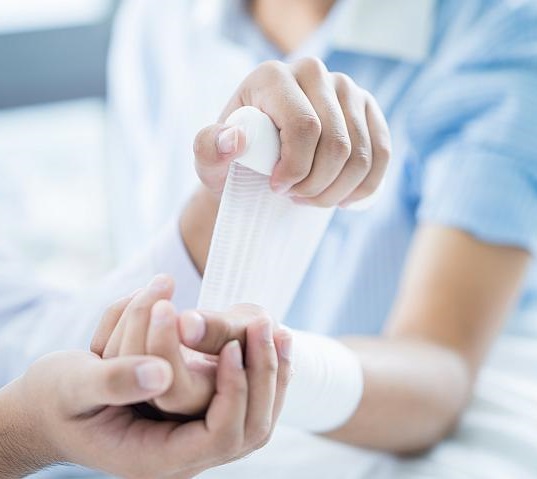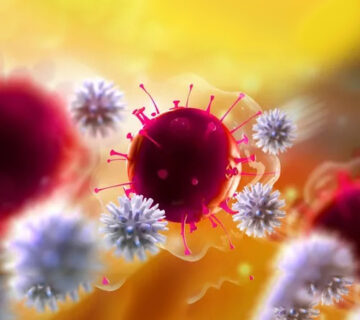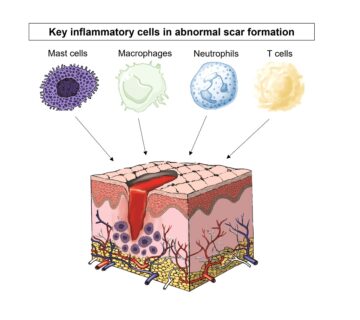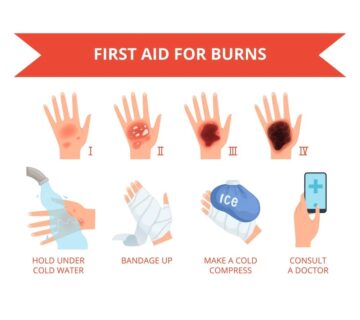Precautions in burn wounds
If possible, wash your hands with soap and water before touching the wound to prevent new germs from entering the wound. If the bleeding of the wound is not clear and not deep, clean and running water can be used first. This reduces the number of germs in the wound and reduces the chance of infection. The skin around the wound can be cleaned with soap and water. Care should be taken not to get soap on the wound, unless the wound is caused by a mammal bite (such as a dog), in which case the wound should be thoroughly washed with soap and water for ten minutes. In the case of ordinary wounds, if the soap penetrates a little into the wound, there is no problem and it is washed with water.
Precautions in deep wounds
If the wound is deep (the fatty tissue of the skin is visible) or the wound is bleeding profusely, it cannot be washed. To treat a burn, you can prevent the pain and inflammation of the burn as much as possible by cooling the burn site for 30 minutes. If the burn is caused by chemicals, wash the burn area with plenty of water or antiseptic serum. For treatment, you can wash with soap and water to remove the dead tissue. If your burn is of another type, it should be checked within 2 days. Because there is little evidence of wound closure for this type of burn. The best thing to do with first degree burns is to not cover them, as this can prolong the healing time.
The first and most important step in the treatment of superficial wounds
The first and most important step in the treatment of superficial wounds caused by everyday events is cleaning the wound site. Considering that contact with an alkaline chemical substance, acids, even with sharp tools, burns, etc., causes wounds, you should disinfect the wound site based on the cause. Since almost one of the most common problems we face are thermal burns such as burns with boiling water, hot steam, iron or even splashing food on the head and face, which causes scarring. To check the progress of the treatment and the occurrence of local infection, it is important to change the bandage every day and observe the wound and the skin without burning.
Preventing hypothermia and reducing contact with bacteria
To prevent hypothermia and reduce contact with bacteria during wound care, dressings are limited to once or twice a day. Avoid submerging the entire body in water to clean the wound as the risk of infection increases. Dressing means putting a protective cover on the wound, the most important prerequisite is the sterile bandage.

Purpose of wound dressing
The purpose of wound dressing is to facilitate wound healing, prevent infection, prevent bleeding, help the wound healing process, thermal insulation, and maintain wound moisture. And wound protection is a mechanical injury. In an open bandage, it is not covered after washing the wound and using the appropriate medicine. It is used in a small amount at the site of injury and is used in clinics and medical centers. In a closed bandage, after the necessary measures, they cover it with sterile gauze or similar materials. New dressings include alginate, hydrocolloid, foam, hydrogel, and clear film. Each of which has certain characteristics of a desirable dress.
Dressing equipment
Dressing equipment including: gauze or sterile dressing: special gauze in different sizes. Pads: cotton and gauze or other fabric layers that are able to absorb secretions.
1- Bandage and glue: used to fix clothes. Bandage, scissors, disinfectants and cleaning materials such as serum and betadine and how to dress the wound. When dealing with any skin wound, the first step is to stop the bleeding. This is discussed in detail in the article “How to Stop Vaginal Bleeding”. After bleeding, the wound should be covered to prevent germs from entering the wound and the patient should be referred to a doctor for special treatment.
2-Sterile gauze: the wound is closed with clean cotton gauze. A special patterned cloth used for wound dressing is called gauze. These fabrics are made with cotton yarn and the texture is very soft, giving it a soft and durable look. Its irregular shape moistens the wound so that it does not absorb secretions and allows the skin around the wound to breathe and sweat. These fabrics are folded several times to reach about 10 cm when folded. The bigger the wound, the more gauze should be applied to the wound. Then it is fixed with gas. If the wound is small, a part of the gauze can be fixed on the skin with special glue. When the wound is large or bleeding, we cover the area with gauze with the help of a bandage.
Wound dressing steps
A bandage is a strip of cloth made of gauze. Placing gases with a tape is called a band. You can use a cotton bandage or elastic band for bandage. The bandage should be tightly closed to apply gentle pressure to the gas. The bandage should not be tied tightly because it can put pressure on the vessels and nerves of the leg and damage them. . In this case, the band should be opened and closed. After the bandage is finished, the patient should be taken to the doctor for final treatment. The dressing should be sterile or very clean. The dressing must be absorbent, because if the sweat does not evaporate, the skin around the wound remains moist and creates a suitable environment for the growth of bacteria, which prevents or delays the healing of the wound.
Precautions after dressing
Before putting on clothes, wash your hands thoroughly with soap and water and dry them. Avoid talking, sneezing, and coughing while wearing clothes. When cleaning a wound, cleaning and disinfection should be done in circular motions from the center to the periphery of the wound. Never wash the wound at the site of the accident, as it increases the risk of infection and aggravates bleeding. Bleeding must be completely controlled before the wound is closed. After applying a sterile gauze or pad to a wound, if it bleeds, never remove it, but apply another gauze, as it will bleed again.
Bleeding in the dressing
If the second dressing bleeds, remove both dressings completely and replace with a new one by applying pressure to the bleeding area. The dressing should cover the entire wound. Place the dressing directly on the wound. Never use the edge of a wound.
Factors of successful wound healing
One of the successful factors of wound treatment is determining the cause of the wound, after the exact cause of the wound is determined, treatment methods can be chosen accordingly. In addition to identifying the root cause of the wound, choosing the right dressing is also very important. The best burn ointments such as calendula, tetracycline and alpha can be used to treat the effects of burns on the skin. In addition to these ointments, you can also use natural anti-burn medicines such as honey and aloe vera. In order to know the best burn ointment, we must have a clear definition of the application and know what we want from the burn ointment. The best measures are pain reduction, reduction of burning sensation, elimination of dark and burning scars, reduction of infection. And for deep and extensive burns, medicinal treatments such as prescription ointments should be used.







بدون دیدگاه